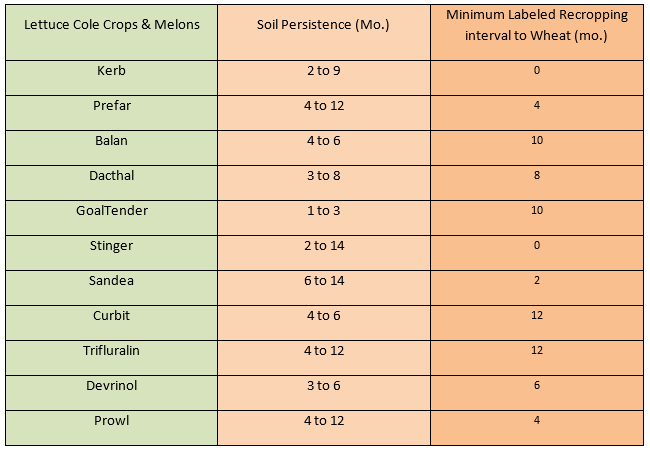
|
|
|
|

|
|||
|
|
|||
|
|
|||
|
Herbicides that have residual activity are very useful here where each irrigation
can bring new weeds. It is difficult to use them, however, where most annual crops
are followed soon after harvest with another crop. We want the herbicide to be active
during the entire growing season and then be gone.
Almost all of the herbicides used on lettuce, cole crops and melons have restrictions on how soon wheat can be planted in rotation after they are applied. Experience has demonstrated, however, that safe intervals can vary considerably based on many factors. The most important of these are rate applied, irrigation practices, tillage, soil type and organic matter left in the field from the previous crop. For example, when Kerb used to be banded at 2 to 4 lbs/ac. after planting and incorporated with furrow irrigation, it was common to see treated bands across wheat fields which followed. This is uncommon now that lower rates are used and applied by chemigation. This chart lists labeled rotational restrictions and normal soil persistence times. In practice, it will be useful only as a general guideline. 
See how herbicides with this mode of action work in the time-lapse photography video.
To contact Barry Tickes go to: btickes@ag.arizona.edu.
|
|||
| Back | |||
|
For questions or comments on any of the topics please contact Marco Pena at the Yuma Agricultural Center.
|
|||
|
Home |
Cotton | Veggies |
Forages | Grains
| Citrus |
Crop x Crop Insects | Diseases| Weeds | Pesticides | Economics | News | Weather | Research | Photos | Contacts | General Info. Copyright © 2001 University of Arizona, College of Agriculture and Life Sciences Webmaster: Al Fournier (acis@ag.arizona.edu) |
|||
